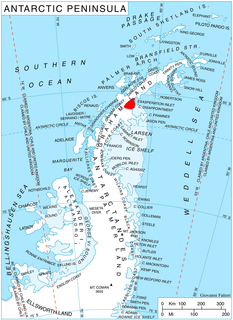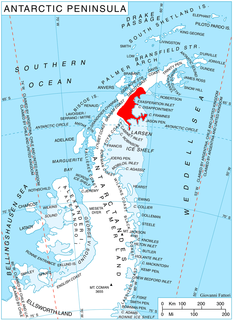
Icebreaker Glacier is a large valley glacier 10 miles (16 km) northeast of Mount Monteagle that flows southeast from the Mountaineer Range to Lady Newnes Bay, Victoria Land, Antarctica. Below Hermes Point its flow coalesces with that of Fitzgerald Glacier. The glacier was named by the New Zealand Geological Survey Antarctic Expedition, 1958–59, as a tribute to the work of the complements of U.S. Navy, and U.S. Coast Guard icebreakers in Antarctic exploration, in supporting scientists and in aiding other ships.
Enchanted Valley is a small snow-filled valley between Walker Peak and Hannah Peak in the southwest end of the Dufek Massif, Pensacola Mountains. The name describes the scenic beauty of the valley and was applied by the United States – International Geophysical Year party from Ellsworth Station that visited the valley in December 1957.

Ambergris Glacier is a glacier flowing south-southeast from Mount Sara Teodora between Chintulov Ridge and Valkosel Ridge to join Flask Glacier just west of Fluke Ridge in Aristotle Mountains on the east coast of Graham Land, Antarctica. One of several names in the area that reflect a whaling theme, it was named in 1987 by the United Kingdom Antarctic Place-Names Committee from the substance secreted by the sperm whale and used in perfumery.

Barrett Glacier is a glacier draining from the north slopes of the Prince Olav Mountains, about 15 nautical miles (30 km) long, flowing between the Longhorn Spurs and the Gabbro Hills to the Ross Ice Shelf. It was named by the Southern Party of the New Zealand Geological Survey Antarctic Expedition (1963–64) for Peter J. Barrett, a geologist with that party.
Carter Ridge is a high and mountainous ridge, 11 nautical miles (20 km) long, located between Coral Sea Glacier and Elder Glacier, in the Victory Mountains of Victoria Land. It was mapped by the New Zealand Geological Survey Antarctic Expedition, 1957–58, and the United States Geological Survey, 1960–62. It was named by the Advisory Committee on Antarctic Names for American chemist Herbert E. Carter, a member of the National Science Board, National Science Foundation, 1964–72, and chairman, 1970–72.
The Organ Pipes is a notable rock cliffs on the northwest side of Jaeger Table, south of Cairn Ridge, in the Dufek Massif, Pensacola Mountains. The name is suggested by the appearance of the feature caused by weathering along prominent vertical joints in the gabbro rock. Named by Arthur B. Ford, United States Geological Survey (USGS) geologist, leader of the USGS Pensacola Mountains survey party, 1978-79.
Guarcello Peak is a peak, 2,050 metres (6,730 ft) high, located 3.5 nautical miles (6 km) south-southeast of Mount Dolence in the Enterprise Hills of the Heritage Range in Antarctica. It was mapped by the United States Geological Survey from surveys and U.S. Navy air photos from 1961–66, and was named by the Advisory Committee on Antarctic Names for Dominic Guarcello, a meteorologist at Little America V Station in 1958. Guarcello Peak was first successfully climbed on December 23, 2011 by Simon Abrahams, Ralf Laier and Todd Passey.

Eijkman Point is the extremity of a rocky spur projecting into Leroux Bay from the west coast of Barison Peninsula on Graham Coast, Graham Land, on the west side of the entrance to Macrobius Cove and 4 nautical miles (7 km) south-southeast of Nunez Point. It was first mapped by the British Graham Land Expedition under John Rymill 1934-37, and was named by the UK Antarctic Place-Names Committee in 1959 for Christiaan Eijkman, a Dutch biologist who in 1890–97 first produced experimental beriberi and initiated work on its prevention.
Finn Spur is a rock spur 3.5 nautical miles (6 km) northeast of Mount Ayres on the north side of Longhurst Plateau, in the Cook Mountains of Antarctica. It was named after Carol Finn, a geophysicist with the United States Geological Survey (USGS), who was USGS project chief on a cooperative USGS–German aeromagnetic survey over the Butcher Ridge – Cook Mountains – Darwin Névé area, 1997–98, and also performed additional aeromagnetic surveys from 1991, including seasons over the West Antarctic ice sheet from 1994 as a principal investigator and USGS project chief.
Hannah Ridge is a narrow, arc-shaped rock ridge, 5 nautical miles (9 km) long, extending westward from Washington Escarpment just north of Brown Ridge, in the Neptune Range of the Pensacola Mountains, Antarctica. It was mapped by the United States Geological Survey from surveys and U.S. Navy air photos, 1956–66, and was named by the Advisory Committee on Antarctic Names for Edward L. Hannah, an aviation structural mechanic at Ellsworth Station, winter 1958.
Hessler Peak is a sharp peak, 1,670 metres (5,480 ft) high, at the south end of Dunbar Ridge in the Heritage Range in Antarctica. It was mapped by the United States Geological Survey from surveys and U.S. Navy air photos from 1961–66, and was named by the Advisory Committee on Antarctic Names for Victor P. Hessler, an ionosphere physicist and United States Antarctic Research Program scientist at the Soviet Vostok Station in the 1965–66 and 1966–67 summer seasons.

McCalman Peak is the 550-metre (1,800 ft) summit of an east–west trending ridge 3 nautical miles (6 km) north of Crystal Hill, 3.97 km east-northeast of Gornik Knoll, 6.9 km south-southeast of Kumata Hill and 4.55 km west-southwest of Zaldapa Ridge on Trinity Peninsula, Antarctica. It was named by the UK Antarctic Place-Names Committee for Donald McCalman, a surveyor with the Falkland Islands Dependencies Survey at Hope Bay in 1958–59.
Temnikow Nunataks is a rather scattered group of low rock outcroppings over an area of about 6 nautical miles (11 km), located at the east margin of Dyer Plateau and 5 nautical miles (9 km) west of Kelley Massif in Palmer land. Mapped by the United States Geological Survey (USGS) in 1974. Named by Advisory Committee on Antarctic Names (US-ACAN) for Nicolas Temnikow, United States Antarctic Research Program (USARP) biologist at Palmer Station in 1974.

Rachel Glacier is a glacier on the east coast of Graham Land, 6 nautical miles (11 km) long, flowing east between Krupen Ridge and Padesh Ridge to enter Exasperation Inlet southwest of Mihaylovski Crag. The name, applied by United Kingdom Antarctic Place-Names Committee (UK-APC), is taken from Herman Melville's Moby Dick, the Rachel being a ship from Nantucket which met the Pequod and brought news of a lost whaleboat.
Rampart Ridge is a prominent broken ridge on the west side of the Royal Society Range, standing north of Rutgers Glacier and extending from The Spire to Bishop Peak. Surveyed and given this descriptive name in February 1957 by the New Zealand Northern Survey Party of the Commonwealth Trans-Antarctic Expedition, 1956-58.
Kessler Peak is a conspicuous cone-shaped peak, 2,180 metres (7,150 ft) high, in the Queen Alexandra Range of Antarctica, standing at the east side of Lennox-King Glacier, 4 nautical miles (7 km) west-southwest of Mount Rotolante. It was named by the Advisory Committee on Antarctic Names for Captain Charles L. Kessler, U.S. Navy, Director of Selective Service System for Virginia. Kessler was a member of the ship's party on the Byrd Antarctic Expedition (1928–30) and revisited Antarctica in 1962 and 1965.
Ronald Ridge is a narrow ridge, 5 nautical miles (9 km) long, located 1 nautical mile (1.9 km) west of Donald Ridge, which it resembles, in the Pioneer Heights, Heritage Range, Antarctica.
Lammers Glacier is a large glacier flowing east along the north side of Godfrey Upland into the Traffic Circle and Mercator Ice Piedmont, on the east coast of Graham Land, Antarctica. This glacier appears indistinctly in an aerial photograph taken by Sir Hubert Wilkins on December 20, 1928, but shows more clearly in aerial photographs taken by Lincoln Ellsworth in 1935 and the United States Antarctic Service in 1940. It was resighted in 1947 by the Ronne Antarctic Research Expedition under Finn Ronne, who named it for Lester Lammers, who had contributed nine grown husky dogs and four puppies to the expedition.
The Lands End Nunataks are two rock nunataks 2 nautical miles (4 km) north-northwest of Airdrop Peak at the north end of Ebony Ridge, Antarctica. The nunataks lie at the east side of the terminus of Beardmore Glacier and mark the northern termination of the Commonwealth Range at Ross Ice Shelf. The descriptive name was recommended to the Advisory Committee on Antarctic Names by John Gunner of the Ohio State University Institute of Polar Studies, who, with Henry H. Brecher, measured a geological section here on January 16, 1970.







